The Beginnings of the Mallard Creek Barbecue… looking back from 2009
Mallard Creek Presbyterian Church’s annual barbecue reaches a milestone this year. It has been 80 years since the first barbecue was held and is it not odd how the old saying that history has a way of repeating itself has once again proved true. When you read the local, national and world headlines of 2009 you might think you are back in 1929. Wall Street and the banking industry have been faced with dark and dismal outlooks, unemployment is at an all time high, people are losing their homes, businesses, retirement funds and there is war being fought somewhere in the world.
 The church leaders of 1929 faced similar difficulties that many of us have in 2009. They had built a building to house the Sunday School rooms here at the church in the good times and were unsure how they were going to be able to pay off the debit. They needed to raise the funds and what better way to reach people than thru food. In late 1928 or early 1929, Pastor Dr. W.H. Frazer and his brother, Ben Frazer held a mens meeting that included a barbecued pig. Everyone enjoyed the food and good fellowship, thus the ideal of having a fall barbecue for the entire church and surrounding community was agreed upon and hopefully the church debit would be retired.
The church leaders of 1929 faced similar difficulties that many of us have in 2009. They had built a building to house the Sunday School rooms here at the church in the good times and were unsure how they were going to be able to pay off the debit. They needed to raise the funds and what better way to reach people than thru food. In late 1928 or early 1929, Pastor Dr. W.H. Frazer and his brother, Ben Frazer held a mens meeting that included a barbecued pig. Everyone enjoyed the food and good fellowship, thus the ideal of having a fall barbecue for the entire church and surrounding community was agreed upon and hopefully the church debit would be retired.
That first year the proceeds after expenses were $89.50 which was enough to pay off the debt with a small amount left over. The Annual Mallard Creek Barbecue had been born.
Our forebears were a resourcefully group of men and women. They could fix anything, make anything, and grow almost everything their families needed. There was no Harris Teeter, Food Lion or Wal-Mart where you could buy whatever, in season or not. They realized that to make the Barbecue an annual success for the church they would have to do a lot of preliminary work. Their summer gardens had to produce extra vegetables to be canned for the Brunswick stew. They pledged to raise a pig or two to donate for the meat along with a few chickens which meant extra work providing food and care for the animals. They spent time cutting extra wood for the fires that would be used to cook the meat. They baked pies and cakes, even when sugar was considered a luxury. They gave of their time and talent even as their monies were limited.
As you have been reading along, are you thinking what does this have to do with me? I can’t have a pig or two in the backyard and I can’t even get one tomato to grow on my patio plant much less enough to make 2000 gallons of Brunswick stew. It is all relative if you stop and think about it. We are living in 2009, not 1929. The world has changed but our needs are the same. The 80th Annual Mallard Creek Barbecue is now only 9 months away. Ask yourself what you can do to help out over the next months. Take the day off from work, or several if you are able. Plan to be there on the work days to help clean up the community house and equipment, cut wood for the fires, cook the meat, stir stew or bring a meal.
If it had not been for the dedication and determination of church members for the past 80 years, we would not be getting ready to celebrate this exciting event in the life of Mallard Creek Presbyterian Church. If you have been involved already, we are looking forward to seeing you again. If you have not volunteered yet, this year would be a great time to become a part of something where both the body and soul will be richly blessed.
The BBQ at 20-something
By the end of the 1940s, the Mallard Creek Barbecue was celebrating its 20th year anniversary. The local community had embraced the annual fall event with great support. The date of the barbecue was established to be the fourth Thursday of October in an effort to avoid a conflict with Halloween celebrations. It was also known to be the maid’s “day-off” for the Charlotte movers and shakers. It provided an opportunity for them to visit the country and have a great meal at the same time.
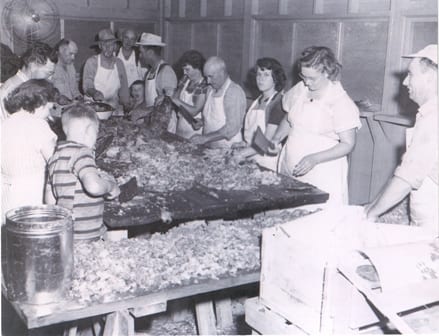
Church families continued to raise and donate hogs for the barbecue during the 1940s. Each year piglets were purchased and placed with a family to be fattened up for the big day. The barbecue committee used proceeds from the previous year to provide the pigs, along with corn for feed and to have the hogs vaccinated. On the day before the barbecue, the men went around to the various farms to collect the hogs. They were taken to the home of Mr. H.Y. Galloway to be killed and dressed out. The hogs were then taken to the community house to be cooked through the night. Several long ditches were dug in the ground that stretched from the ticket stand almost down to the woods. The racks were placed on the dirt banks and hickory coals were shoved underneath to slow cook the whole hogs. The aroma was so strong that people from miles around came to watch and take in that special smell only barbecue has! That smell has had the same effect on people ever since as they often stop by to see what is going on at the community house on the cook days!
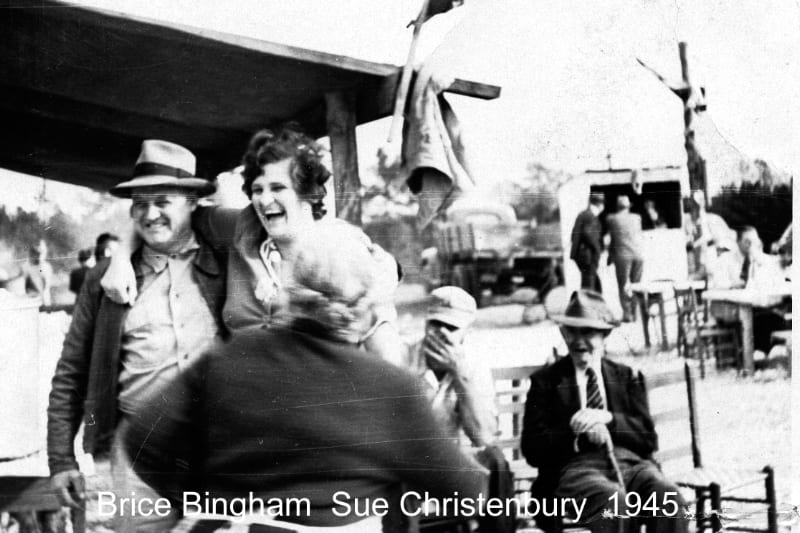 Starting in 1946, the hogs were taken to the abattoir in Charlotte to be prepared for cooking. The long ditches were no longer used as a new block building was built to cook the meat in. Once the meat was done, the pits were closed over and serving lines were set up inside the building. The meat was chopped in a shed and served directly to the plates and sandwiches. A time came when it was necessary to cook the meat inside a screened building. The cooking was moved to the home of J.W. “June” Oehler, Jr. The meat was cooked the day or so before and stored in coolers and transported to the community house on the day of the barbecue. When the long screened-in building was built, the cooking was moved back to the community house. The tradition of families providing the hogs also come to a close and the meat was purchased from suppliers, first as whole hogs and now butts, hams and shoulders. Because of the growth of the annual barbecue, the meat is cooked the Thursday and Friday before the big day. The use of metal cookers has replaced the dirt pits. Some of the meat is still cooked on the open pits inside the screened-in building. One thing is certain though, the barbecue is the same because it is cooked with a tradition of knowledge and fellowship as from the beginning.
Starting in 1946, the hogs were taken to the abattoir in Charlotte to be prepared for cooking. The long ditches were no longer used as a new block building was built to cook the meat in. Once the meat was done, the pits were closed over and serving lines were set up inside the building. The meat was chopped in a shed and served directly to the plates and sandwiches. A time came when it was necessary to cook the meat inside a screened building. The cooking was moved to the home of J.W. “June” Oehler, Jr. The meat was cooked the day or so before and stored in coolers and transported to the community house on the day of the barbecue. When the long screened-in building was built, the cooking was moved back to the community house. The tradition of families providing the hogs also come to a close and the meat was purchased from suppliers, first as whole hogs and now butts, hams and shoulders. Because of the growth of the annual barbecue, the meat is cooked the Thursday and Friday before the big day. The use of metal cookers has replaced the dirt pits. Some of the meat is still cooked on the open pits inside the screened-in building. One thing is certain though, the barbecue is the same because it is cooked with a tradition of knowledge and fellowship as from the beginning.
Mr. J.W. Oehler, Sr. was the barbecue master/committee head from 1929 until his death in 1943. Mr. J.A. Kirk took over as the head of the barbecue committee and served from 1944 through 1965. After years serving as the barbecue master, Mr. J.W. “June” Oehler, Jr. became the chairman of the barbecue committee in 1966 and continued until 1978. In the 50th year 1979, his sons, Donnie Oehler was appointed Chairman with Craven Oehler as Co-chairman. These two men, who had grown up with barbecue in their veins, guided the annual barbecue for the next 29 years. In 2008, Charles Kimrey and Bill Wood took over as Co-chairmen. They are supported by experienced members who have been working many years and will be sure to advise them on how it is done! We look forward to the new leadership for at least 20 years!
Ann Christenbury Carroll – March 2009
The BBQ in the 1960s
The annual barbecue had been around for 30 years as the 1950s came to an end. There had been two major wars; WWII and the Korean War. The United States was changing from a mostly agrarian culture to an industrial based society. Young men and women were leaving the family farm for work in the city. Mallard Creek was no exception as the number of full time farmers dwindled to just a few as they mostly raised cash crops like cotton, corn, and cows. Gone were the days of providing all the essentials of supporting family life from the fields and gardens.
The barbecue had become an annual ritual of harvest time. It was known far and wide for the 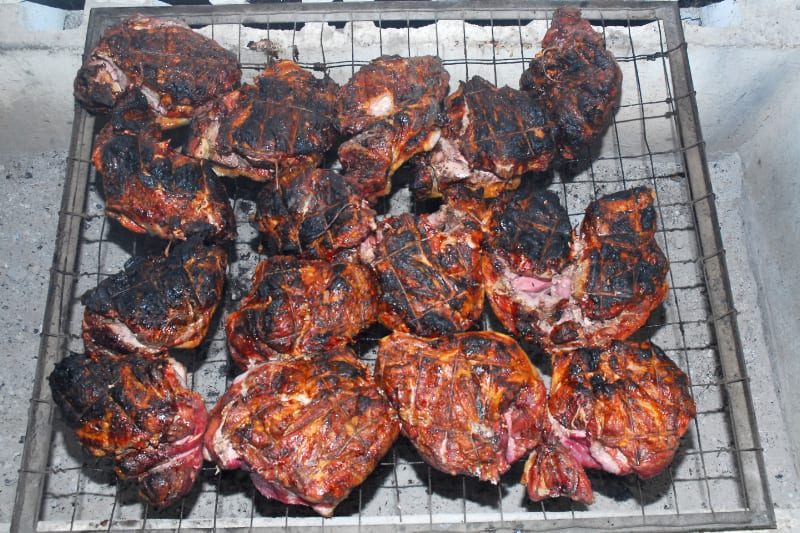 excellent barbecue, but with the addition of the Brunswick stew, it became an equal draw for the customers. It is not noted when the first year the Brunswick stew was added to the menu, but it soon became a favorite side dish. As with the hogs, in the beginning the chickens, tomatoes and butter were donated by the church families. The Brunswick stew started cooking in the early morning hours of Barbecue Day. The line of pots went from the back of the chopping shed towards the road. The women prepared the ingredients as the men built the wood fires beneath the cast iron pots. It was reported that the smoke was so great you could hardly see the men as they stirred the stew. The pots were also donated for use on Barbecue Day by various members. In the book of newspaper clippings there is an article relating the story of one such pot. It was given to Mallard Creek by Mr. Osmond Barringer of Poplar Tent. It was over 100 years old and had belonged to his uncle, General Paul Barringer (USC). The pot was nearly four feet in diameter, had a 60 gallon capacity, and weighed at least 200 pounds. One year on the night before the barbecue, all of the pots and gas lines were stolen. When the theft was discovered, it was a miracle that enough pots were located and installed in time to get the stew going. That is the reason why a guard is on duty at the community house during barbecue week.
excellent barbecue, but with the addition of the Brunswick stew, it became an equal draw for the customers. It is not noted when the first year the Brunswick stew was added to the menu, but it soon became a favorite side dish. As with the hogs, in the beginning the chickens, tomatoes and butter were donated by the church families. The Brunswick stew started cooking in the early morning hours of Barbecue Day. The line of pots went from the back of the chopping shed towards the road. The women prepared the ingredients as the men built the wood fires beneath the cast iron pots. It was reported that the smoke was so great you could hardly see the men as they stirred the stew. The pots were also donated for use on Barbecue Day by various members. In the book of newspaper clippings there is an article relating the story of one such pot. It was given to Mallard Creek by Mr. Osmond Barringer of Poplar Tent. It was over 100 years old and had belonged to his uncle, General Paul Barringer (USC). The pot was nearly four feet in diameter, had a 60 gallon capacity, and weighed at least 200 pounds. One year on the night before the barbecue, all of the pots and gas lines were stolen. When the theft was discovered, it was a miracle that enough pots were located and installed in time to get the stew going. That is the reason why a guard is on duty at the community house during barbecue week.
The stew began as more of a thick soup with lima beans and potatoes added to the chicken and tomatoes. Jennie Foster and Mary Oehler oversaw the preparations and cooking for the first 20 years or so. In the late forties, Beck McLaughlin took over and history was made! Beck had attended the very first barbecue in 1929 with her fiance, Smiley McLaughlin and quickly found her spot in the stew department. She became stew chairperson and perfected the recipe into the one that is used today. The beans and potatoes were deleted as rice, chicken, beef, pork, tomatoes, and butter became the main ingredients. Someone once asked how she knew when the stew was done and the reply was “when it is seasoned till it tastes right, and cooked till it looks right.” There are probably a few secret ingredients but rest assured, squirrel is not one of them!
 Over the years the Brunswick stew recipe has been tweaked a bit but the way it is cooked has changed little. The men were the first stirrers of pots over the open ditches. Then several brick fire ovens were built using gas for the heat source. After construction of a new “stew house” the cooking was moved inside. It requires constant stirring to keep the stew from sticking to the iron pots so it was decided to hire help to free up the men to do other jobs on Barbecue Day. The ladies from the surrounding area were asked if they would be willing to do this work for pay. They agreed and, like many other positions around the barbecue, their paddles have been passed down thru the generations.
Over the years the Brunswick stew recipe has been tweaked a bit but the way it is cooked has changed little. The men were the first stirrers of pots over the open ditches. Then several brick fire ovens were built using gas for the heat source. After construction of a new “stew house” the cooking was moved inside. It requires constant stirring to keep the stew from sticking to the iron pots so it was decided to hire help to free up the men to do other jobs on Barbecue Day. The ladies from the surrounding area were asked if they would be willing to do this work for pay. They agreed and, like many other positions around the barbecue, their paddles have been passed down thru the generations.
It was not long before the patrons of the barbecue wanted to “take some home” with them. Brunswick stew was a great meal to eat on a cold winter night. It is one church family’s tradition to have Brunswick stew for their Thanksgiving Dinner meal. The demand for the stew soon made it impossible to cook it all on the day of the barbecue. Beck McLaughlin’s nephew Richard Wallace, along with his wife Linda, took over as co-chairmen of the stew department. They start the process early in the week by doing several “batches” to have on hand for the take home requests. There are many church members who help with making the stew, from washing buckets, cutting up chickens, setting up the gas lines to stirring the big pots. It is hard work but the reward is a cup of stew on Barbecue Day which makes it all worthwhile.
Ann Christenbury Carroll – April 2009
The Granddaddy of Barbecues
By the 1960s the annual Mallard Creek Barbecue had become known as the “Grand-Daddy of Barbecues” around Charlotte and across the state of North Carolina. Many other churches and organizations had seen the success of our barbecue and started their own. But they all looked up to the Mallard Creek Barbecue, often imitated but never duplicated! The Mallard Creek Barbecue is known far and wide as the best place for great food, fellowship, and to be seen and heard.
Once the day of the annual barbecue was set for the 4th Thursday in October, it did not take the politicians long to figure out it was one of the last informal gatherings of the masses prior to Election Day in November. They soon began showing up with their pamphlets and handshakes in hopes of securing a vote. Both Republicans and Democrats work hard but it is doubtful if either party makes much headway. Hands are barely released by one politician before being grabbed by a representative of the other party!
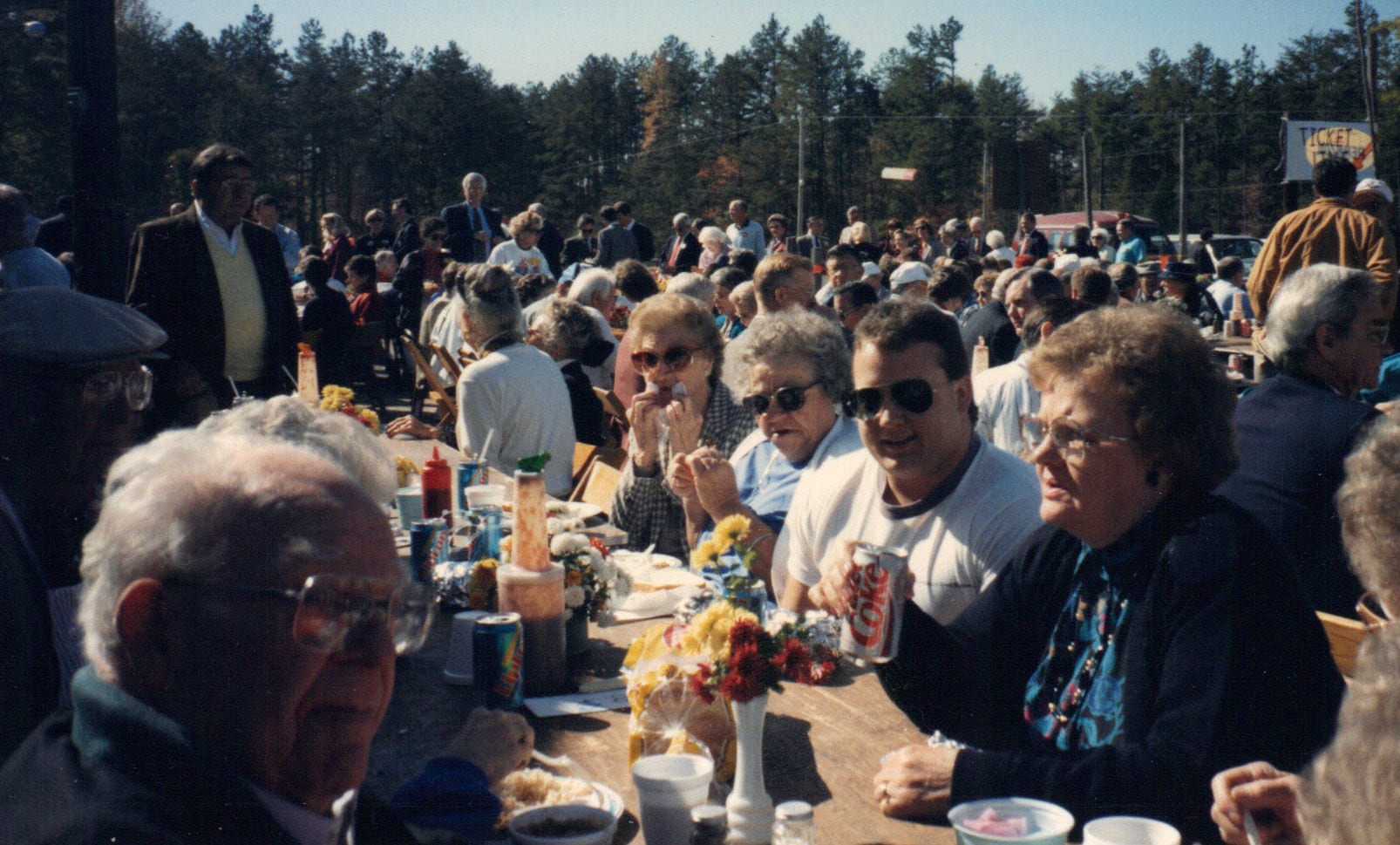 Over the years the barbecue workers have learned that the politicians bring the good with the not-so-good. The good means that in years of national elections, a larger crowd can be expected to attend. The barbecue has seen everyone from a Vice-President nominee to the local dog catcher, with every office in between. The not-so-good includes roadside political signs and loose pamphlets on tables and cars. Finally, it was decided that if you can’t beat them, might as well include them. A make-shift political gauntlet has been set aside for the politicians to meet and greet voters. However not everyone who comes to the barbecue wants to bother with meeting the candidates for mayor or governor. They are only there for the food, fresh air and seeing old friends. A ticket line to bypass them is just as busy, along with a trash can for the political junk!
Over the years the barbecue workers have learned that the politicians bring the good with the not-so-good. The good means that in years of national elections, a larger crowd can be expected to attend. The barbecue has seen everyone from a Vice-President nominee to the local dog catcher, with every office in between. The not-so-good includes roadside political signs and loose pamphlets on tables and cars. Finally, it was decided that if you can’t beat them, might as well include them. A make-shift political gauntlet has been set aside for the politicians to meet and greet voters. However not everyone who comes to the barbecue wants to bother with meeting the candidates for mayor or governor. They are only there for the food, fresh air and seeing old friends. A ticket line to bypass them is just as busy, along with a trash can for the political junk!
Forty years had seen a whole generation born into the barbecue. The original workers were turning some of their duties over to the “young folks”. These young people had grown up learning the art of cooking barbecue and stew by watching their parents and elders. As soon as they were tall and strong enough, they were cutting wood, stoking the fires, carrying buckets, picking up trash and anything else they were asked to do. The teachers at Newell and Derita knew there was no serious work to be expected from the Mallard Creek kids on Barbecue Day. They could not wait for school to be over so they could hurry to the barbecue. And forget about giving any homework!
As we approach the 80th year in 2009, another generation or two has grown up with the barbecue being an important event in their lives. The older folks are slowing down as their children, grandchildren and even great-grandchildren are carrying on the jobs it takes to get things done to undertake such a large endeavor as the annual barbecue.
The youth of Mallard Creek have been very active in helping with the preparations. They have washed buckets, set out chairs and tables, and then put them away afterwards. They carry supplies from one location to another. They check to see if school will be out the week of the barbecue because they know there is no skipping class like their parents once did!
Remember, you do not have to be connected to any long-time family of Mallard Creek Presbyterian Church to become a part of the barbecue tradition. All it requires is for you to come, join the fellowship, and bring your children with you. It is an experience that will last a lifetime. Just ask anyone who was there last year!
Ann Christenbury Carroll – May 2009
The BBQ at Fifty – 1979
In 1979 the Mallard Creek Barbecue celebrated the 50th year! What an accomplishment for a church located out in the country. From humble beginnings of two pigs and a goat barbecued for a church fund raiser, the annual event had become a major undertaking. It now took almost a full week prior to prepare for the big day. By the 1970’s the amount of meat cooked had increased to 4,800 pounds. The slaw was 2,000 pounds and the Brunswick stew was 250 gallons. The profit amount had increased to over $15,000 a year. The church was able to build the chapel/education wing with Sunday School rooms and a manse for the minister’s family. The new sanctuary was built in 1957. In the early 1970’s the Activities Building with a full size gym, kitchen and dinning hall, and meeting rooms was completed. All of these buildings were funded and paid in full by the proceeds from 50 years of Barbecue Days!
Here are a few pictures from the 1979, 50th Year barbecue. See how many people you can name!
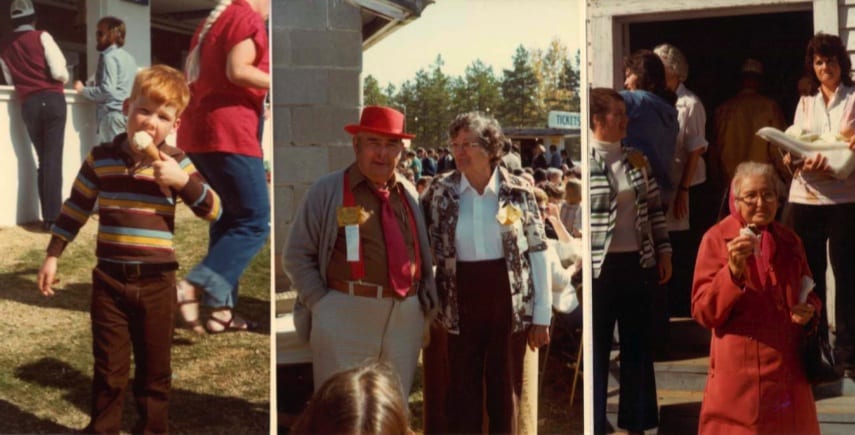
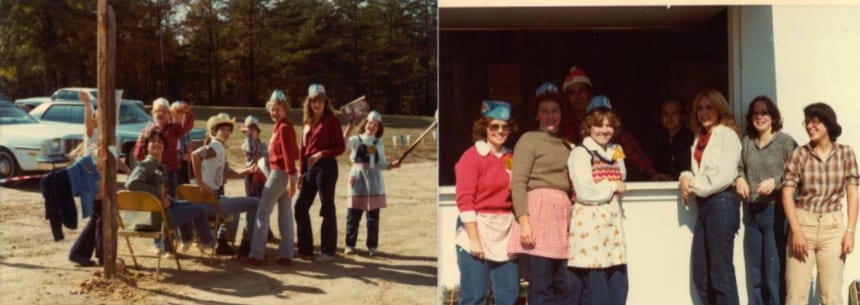
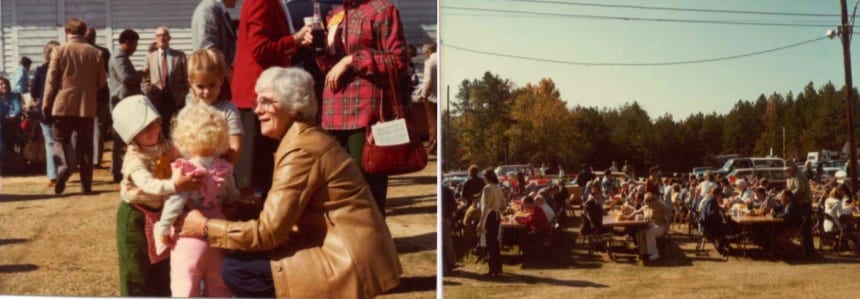
The 75th Annual BBQ – 2004
When I began the project of putting together a pictorial essay on the annual Bar-B-Que, I came to realize that no matter the year or the group of people working, it has always been the same. In this modern world of constant change, it gave me a sense of respect and appreciation in knowing there are some things that never change. It is like God’s love, ever constant, ever sure.
It didn’t matter if it was 1929 or 2004, the hickory coals come from fires started early in the morning. The meat is still hand turned and the hams and shoulders are checked with a stick, knocking off the ash dust, loosening up the skin as it burns to a brown crisp. The meat is chopped, cooled and seasoned. I still think that is the best time to eat bar-b-que. In the olden days, that was the way it was served to the crowds – from fire to chopping table to plate. We have come a long way from 4 pigs and a goat! It now takes 2 days to cook and prepare all the meat.
When I compare the earliest pictures from the 1930s and 1940s, to the 1950s, 1970s and 2004, I see the same familiar family faces: Father to Son, Son to his Son/Daughter, to Grandchild and Great-grandchild. Talk about family traditions! Even if you are not connected in some way to the first families of the bar-b-que, you can start your own family tradition with your children in 2004.
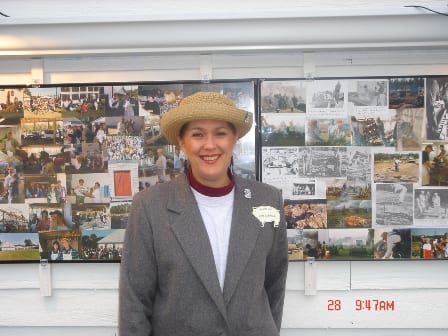 I never realized exactly how much slaw there is in 2 tons until I started helping to mix. There is something awesome about seeing 75 bags of cabbage at 50 pounds each and knowing you have touched every single head of it. The mixing of slaw is sort of like playing in the sand at the beach. Pile it up, smooth it out, mix in onions, celery and carrots, pile it up again, and then add vinegar, sugar, salt and pepper, mix it all up again. My mother, Sug Christenbury, told me that when she started helping at the bar-b-que, she worked with Mr. Brice Bingham mixing the slaw. Now she is working alongside of his grandchildren and great-grandchildren, mixing slaw.
I never realized exactly how much slaw there is in 2 tons until I started helping to mix. There is something awesome about seeing 75 bags of cabbage at 50 pounds each and knowing you have touched every single head of it. The mixing of slaw is sort of like playing in the sand at the beach. Pile it up, smooth it out, mix in onions, celery and carrots, pile it up again, and then add vinegar, sugar, salt and pepper, mix it all up again. My mother, Sug Christenbury, told me that when she started helping at the bar-b-que, she worked with Mr. Brice Bingham mixing the slaw. Now she is working alongside of his grandchildren and great-grandchildren, mixing slaw.
I have not had the experience of helping to prepare for the Brunswick Stew, so I can’t tell about it first hand. I do think it is most likely the hardest job at the bar-b-que. There are so many steps and ingredients. What a disaster it would be if something were left out. I can tell from the pictures that there is a “whole lot of stirring going on”! Some people may not be aware of the fact that the ladies who spend all day on Thursday stirring those big pots of stew also have long ties to the bar-b-que. These spots are also handed down from mother to daughter, aunt to niece.
Wednesday night is almost like Christmas Eve. Everyone is bustling about, getting the serving lines ready, putting out the tables and chairs, and getting the sandwich stand stocked with cold drinks. There are only a few things that are not done the old way and one of those is “wrapping silverware.” As a young person, I always thought this was a special time for fellowship. It was also a time for anyone who might not be able to work all day on Thursday to feel that they did their part. All those women, (and a few men), all together doing the same thing; talking, talking, and talking. Those little rubber bands were not the easiest things to work with either. We still have the flowers. That has always been one of my favorite things about the “getting ready” part. All those beautiful flowers, the scents, and sneezes too. Even if you think your arrangement looks awful, who can tell when they are all put together and then placed on the tables?
As Wednesday afternoon turns to dusk, the tables and chairs are spaced at just the correct measurement, sawdust is spread out and the “Pig” is put in it’s place of honor above the sandwich stand. Everyone is waiting with anticipation for Thursday morning. Is it going to rain? Will there be a frost? We all pray for a beautiful, sunny day, cool and crisp with enough nip in the air to make this favorite dish taste just right!.
Thursday. All the preparations are winding down; all the hard work becomes a great celebration. Even if you get there at 8 AM and think you are early, there are people who have already been at it for hours. Everyone stakes out their place for the day. Then before the crowds begin to arrive, we all meet for a time of prayer and thankfulness for another year gone by. We remember the ones who are not here this year. We look at the new babies and hope they will grow up to love the bar-b-que as much as we do and carry on the tradition.
The crowds descend and all time is forgotten. Before you can blink, it is 1:30 PM and you realize you have not even taken a break. You need a sandwich, a drink and an ice cream. I think working in the sandwich stand is the best place to be. You get to meet many people, some you know and many that you don’t. You get to watch the bar-b-que unfold right in front of you. I know the drive-thru is a big money maker, but I always feel those people sitting out there in their cars are missing the heartbeat of the bar-b-que.
The bar-b-que is much more than just a meal. It is a “happening”, almost like a festival. Just like in the beginning, it brings together all types of people; young and old, city and country, neighbors and newcomers. You can get drive-thru at McDonald’s but you can’t get a sense of “community,” which is what the bar-b-que is really about. I have read all the newspaper clippings and there is one re-occurring theme that appears time after time. Mallard Creek Bar-B-Que is our church’s offering to the community, our members, neighbors, old friends and new friends. It is a place where 10,000 people come together to eat, talk politics and enjoy an outing in the friendly atmosphere of country living. The Mallard Creek formula is simple. Good food, good company, good atmosphere.
As the evening shadows fall, the crowd starts to thin out and the people who have been going non stop all day seem to get a second wind and work just as hard to get everything cleaned up and put away until next year before they go home. Everyone is tired, but all know if the Lord is willing and the creek don’t rise, we will all be back next year.
Narrative by Ann Christenbury Carroll, October 2004.
The BBQ in the 1980s
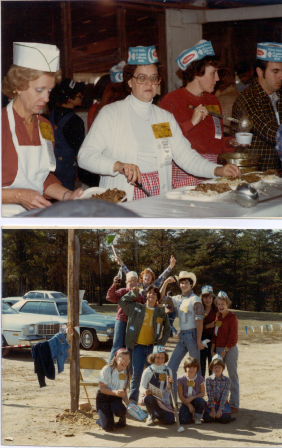 When the Barbecue location moved to the Community House, all of the serving and eating was done inside the large building. The meat and stew were cooked outdoors and prepared in what was known as the “chopping shed”. As the crowds grew larger during the early years, tables were put outside behind the Community House. The people enjoyed the fresh air and country setting but with concerns about the weather, a large tent was erected over the two serving lines. It was not long before the block building was built to house the serving lines and the heating of the meat in the side wing. A shed was built for the stew making and a sandwich stand was placed alongside the chopping shed. This cluster of buildings served well into the 1970?s.
When the Barbecue location moved to the Community House, all of the serving and eating was done inside the large building. The meat and stew were cooked outdoors and prepared in what was known as the “chopping shed”. As the crowds grew larger during the early years, tables were put outside behind the Community House. The people enjoyed the fresh air and country setting but with concerns about the weather, a large tent was erected over the two serving lines. It was not long before the block building was built to house the serving lines and the heating of the meat in the side wing. A shed was built for the stew making and a sandwich stand was placed alongside the chopping shed. This cluster of buildings served well into the 1970?s.
In 1979, the year of the 50th anniversary, the Barbecue Committee made the decision to build several new buildings to improve the flow on Barbecue Day and cooking days. Like in the beginning, several church members that were considered to be “jacks of all trades” were put in charge of getting these built. It was a sight to see! The old chopping shed, stew area and sandwich stand were torn down and replaced with the long screened cooking hall. The stew received a new and improved station and the sandwich stand occupied the front of the building. A lot of the old timers of Mallard Creek will remember the old 2 stall bathroom house! Everyone was glad when the new bathroom building was built.
The Mallard Creek Barbeque has been blessed with outstanding weather on Barbeque Day with the exception of only several rainy days. It was during one such day that a big yellow and white striped tent was added to the compound. The tent was greatly appreciated and served its purpose for a number of years.The newest additions to the barbeque grounds have given us the ability to keep serving during inclement weather. These include the covered eating area beside the serving building and the covered drive up lanes. A new and much improved wash area has been completed along with a loading ramp for easy access to the holding trailers on barbeque day.
Once again, the construction of these structures was done with volunteer help. It was amazing to see the original barbeque workers handing over the reins of these projects to the next generation. That is how and why the Annual Mallard Creek Barbeque will continue on in the years to come.
The Barbeque Committee sends thanks to everyone that has been a part, be it small or large, in this fellowship building activity of Mallard Creek Presbyterian Church. We also once again extend the invitation to anyone who has not participated to join with us this year. You will be glad you did!
The Community House
Have you ever wondered why the large white building where the barbecue is held is called The Community House? What exactly is a community house, and what is the history of that building?
To understand the importance of The Community House is to know the history of the Mallard Creek community. Mallard Creek Presbyterian Church was founded in 1824. That was only 37 years before the start of the Civil War. The local children were schooled in several small one room buildings; the Mallard Creek School, Oehler School and Union School (located near where Concord Mills Mall is today.)
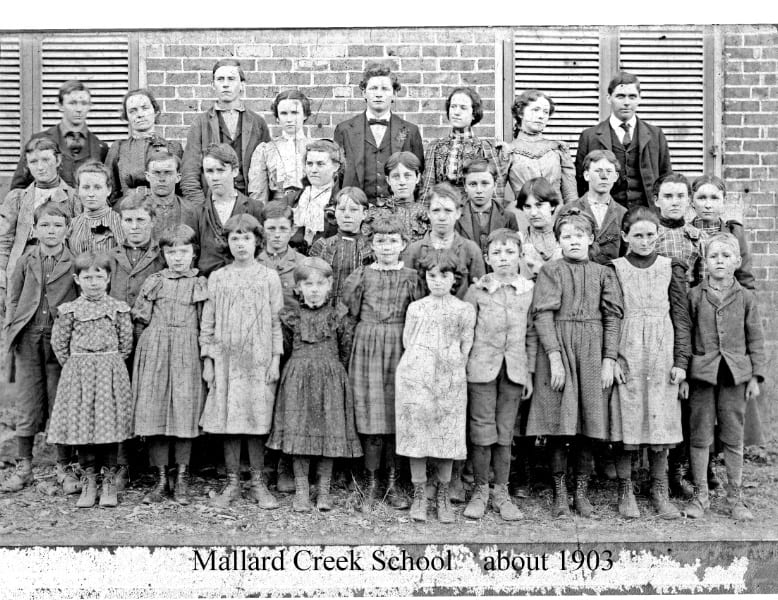 Mecklenburg County experienced an economic boom in the years following the end of the Civil War that would last in large part until the Great Depression. Cotton was King. The majority of the families in the Mallard Creek community were cotton farmers. This area became an important part of the textile manufacturing industry and cotton crops equaled prosperity. These people understood the importance of a good education and in August of 1920 the Mecklenburg County Board of Education accepted a donation of land for a new school by the Crenshaw and Cochrane families. The State Department of Education provided $1500.00 towards construction cost and the old Mallard Creek and Oehler Schools were sold for the additional funds needed. As was the long standing tradition of rural communities, the new building was constructed entirely through the volunteer efforts of MCPC. Men from nine families were able to build this new school in time for classes to start that fall.
Mecklenburg County experienced an economic boom in the years following the end of the Civil War that would last in large part until the Great Depression. Cotton was King. The majority of the families in the Mallard Creek community were cotton farmers. This area became an important part of the textile manufacturing industry and cotton crops equaled prosperity. These people understood the importance of a good education and in August of 1920 the Mecklenburg County Board of Education accepted a donation of land for a new school by the Crenshaw and Cochrane families. The State Department of Education provided $1500.00 towards construction cost and the old Mallard Creek and Oehler Schools were sold for the additional funds needed. As was the long standing tradition of rural communities, the new building was constructed entirely through the volunteer efforts of MCPC. Men from nine families were able to build this new school in time for classes to start that fall.
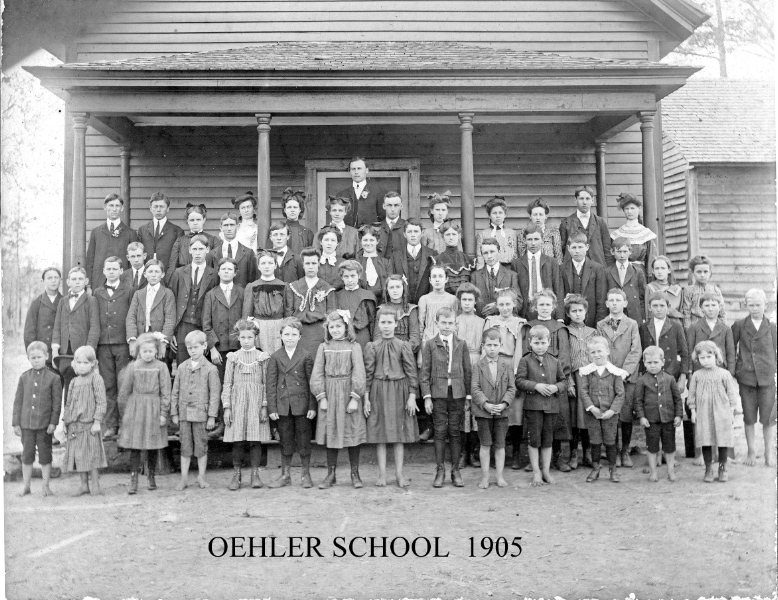 The Mallard Creek School became a focal point of activity from its opening. Community and church social events, such as church picnics and baseball games were often held on the school grounds. Community plays, recitals, and other programs were held inside the large building. The Mallard Creek School held classes for children through the tenth grade for eleven years. In 1931 the School Board opened two new and larger schools in nearby Derita and Newell. It was only logical that the Mallard Creek Presbyterian congregation, whose families had built the building and supported the school during its eleven years of service, was interested in purchasing the structure. The price was $250.00 when it was offered for sale by the State.
The Mallard Creek School became a focal point of activity from its opening. Community and church social events, such as church picnics and baseball games were often held on the school grounds. Community plays, recitals, and other programs were held inside the large building. The Mallard Creek School held classes for children through the tenth grade for eleven years. In 1931 the School Board opened two new and larger schools in nearby Derita and Newell. It was only logical that the Mallard Creek Presbyterian congregation, whose families had built the building and supported the school during its eleven years of service, was interested in purchasing the structure. The price was $250.00 when it was offered for sale by the State.
It was renamed The Mallard Creek Community House. Since 1932 it has been the home of the annual barbecue. Through the years it has served as a meeting place for the youth groups of the church, the 4-H club, the Boy Scouts and Girl Scouts. The annual Halloween Carnival was held there until the church built the Activities Building in the 1970’s. The YMCA used the grounds for programs for several years in the mid 1990’s. Since The Optimist Club built new fields, baseball and soccer games are played there again.
From its construction in 1920 to the present day, the Mallard Creek School has remained an integral part of the Mallard Creek community. It is a tangible reminder of life in rural America, as it provides a common place where the community can come together for many different activities. It is the Mallard Creek “Community House”.
Ann Christenbury Carroll – February 2009